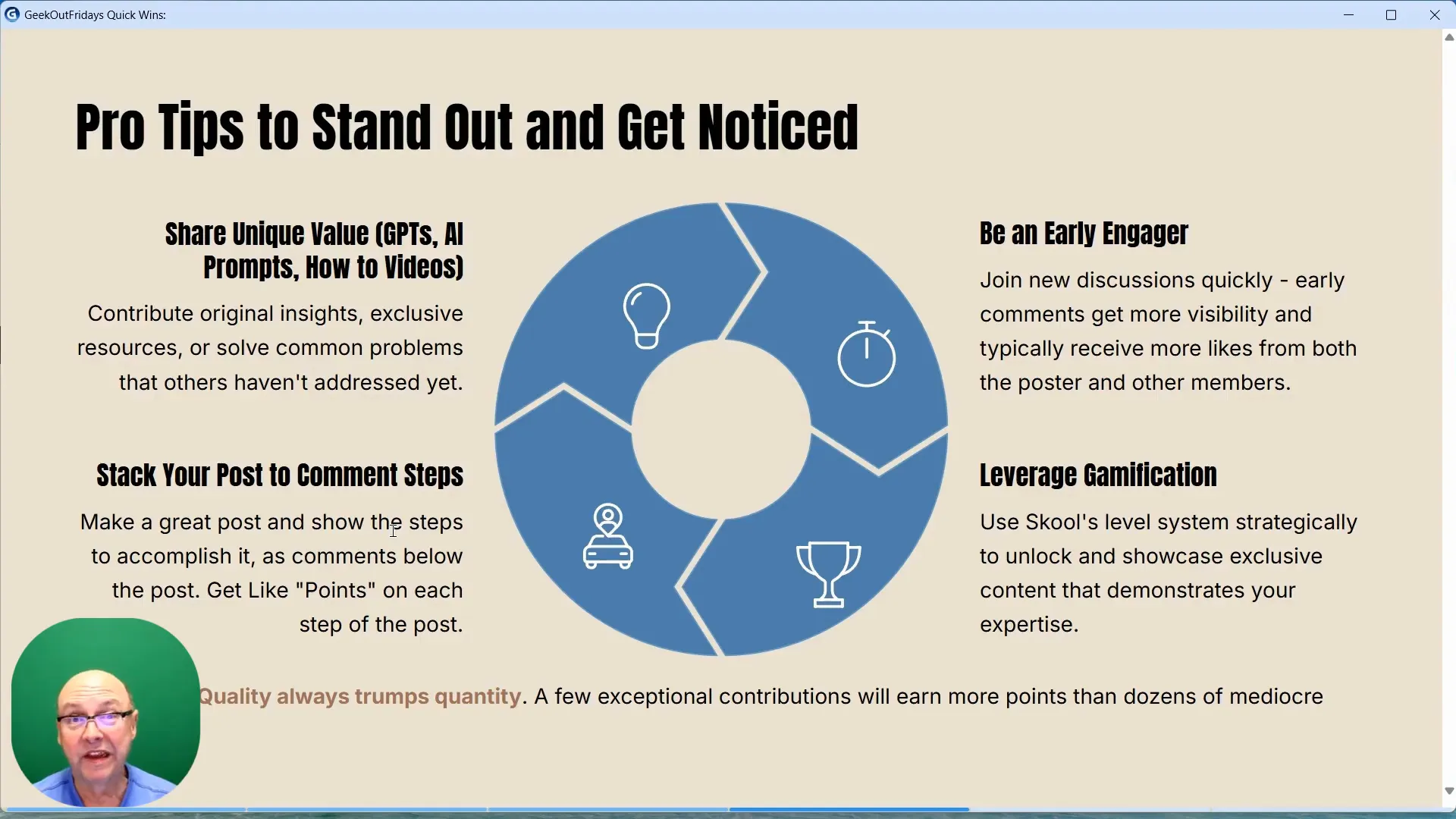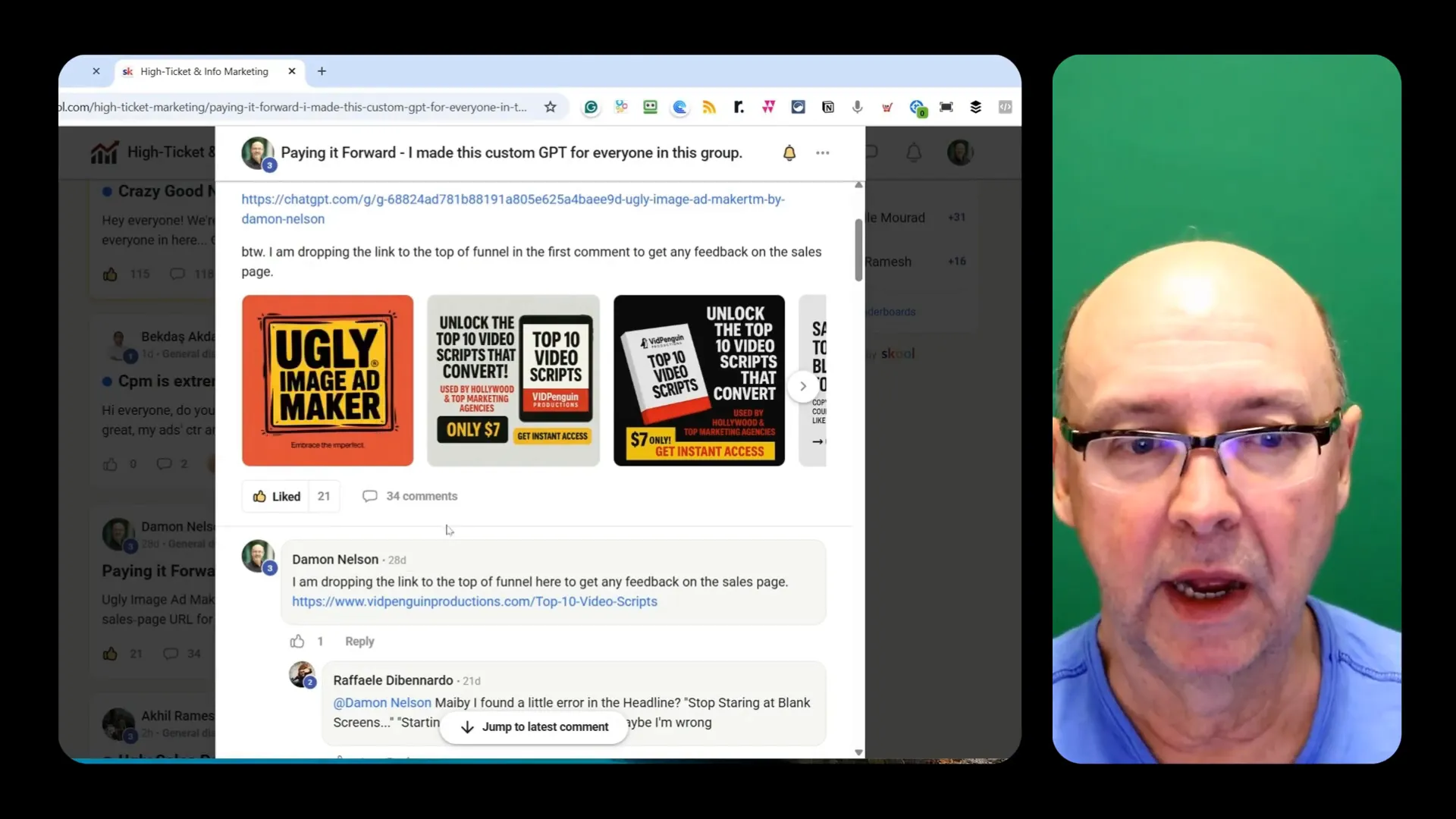Aug 27, 2025
Quick Wins - How to Easily Get Points and Get Noticed in Skool Groups
Hi — I'm GeekOutFridays. In this post I'll walk you through a compact, actionable strategy to climb the Skool group leaderboard, unlock hidden resources and masterclasses, and become a recognizable contributor (and influencer) inside any Skool community. These are the exact tactics I use across multiple groups to get noticed, build authority, and even create opportunities to sell or promote products subtly and ethically.

Why you should care about points, levels, and leaderboards
At first glance, Skool’s points system can look like gamification for the sake of fun. It’s more than that. Points and levels are the currency of visibility inside a Skool community. They do two important things:
- Unlock access: School owners often lock valuable resources (bonus trainings, resource libraries, masterclasses) behind level gates. Reaching a level can literally unlock new content for you.
- Signal authority: Being high on the leaderboard signals to other members and admins that you participate and add value. That perception makes people ask you questions, tag you, and trust your recommendations.
Put simply: points are a bridge between participation and influence.
How Skool points and levels actually work
Understanding the mechanics is the first step to playing smart — not spammy.
- You earn one point for every person who likes your post.
- You also earn one point for every person who likes your comment.
- Points accumulate to create levels. Level thresholds vary, but in my groups Level 2 requires 5 points and Level 3 requires 20. The system shows your level on leaderboards (7-day, 30-day, all-time), so consistent engagement matters.

Because likes are the unit of currency, your goal is to create content and comments that attract likes and prompt replies.
The 7-day quick-win strategy (what to do this week)
Want results fast? Execute this simple plan over 7 days to move up the leaderboard and unlock a level.
- Create 2–3 quality posts: These shouldn't be one-liners. Share value — a quick how-to, a resource, an AI prompt you love, a short screencast or image. Each useful post attracts likes and comments.
- Make strategic comments: Don’t comment “cool” or “nice”. Add extra value, ask a clarifying question, or suggest a next step. Comments that invite follow-up get liked more often.
- Engage early on others' posts: When a new post drops, aim to comment within 24–48 hours. Early engagement compounds visibility and often triggers more interaction.
- Stack posts with comment steps: For one post, put the key steps in the first several comments (label them Step 1, Step 2, etc.). That gives people multiple chances to like — the post plus each comment.
- Track the leaderboard daily: Monitor your 7-day and 30-day positions. If you slip, add another valuable comment or short post to push yourself back up.

If you follow those steps, you can accumulate points quickly without resorting to low-quality spam.
Pro tips — the content formats that win
Not every post is created equal. Here are the content types I consistently use because they drive likes, comments, and shares:
- Short how-to videos: A 30–90 second screen recording showing a single technique or shortcut. People love small, digestible wins.
- GPT / AI prompts: Share a prompt you used and the result. People copy and like posts that save them time.
- Images and quick diagrams: One clear screenshot with a single annotation beats a paragraph of explanation.
- Resource packs: A short list of links to templates, plugins, or tools with a sentence about how you used them.
- Step-based comments: As mentioned — break tutorials into comment steps so each comment can be liked.
My personal rule: give more value than you ask for. Instead of posting “Anybody tried X?” — post “Here’s how I tried X and what happened. Curious about your results.” That invites responses but starts from giving value first.
Practical templates you can copy
Here are short templates you can use immediately when posting or commenting.
Post template (How-to / Resource)
"Quick win: How I [achieved result] in [time]. Steps: 1) [Step], 2) [Step]. I used [tool/resource]. Screenshot/result below. Curious how you'd tweak this?"
Comment template (value + invite)
"Nice post — two quick additions that helped me: 1) [tip], 2) [shortcut]. If you want, I can drop the exact prompt/config I used."
These templates are short, useful, and end with an invitation — which naturally generates replies and likes.
Stacking comments — why it works and how to do it
Stacking comments is a powerful technique that’s often overlooked. The idea is simple: for a single post, create a short thread of comments that break a topic into multiple micro-answers. Each comment is an opportunity for someone to “like” you — multiplying points.
- Make the post a teaser: "Steps are below in the comments."
- Drop Comment #1: "Step 1 — [action], why it matters."
- Drop Comment #2: "Step 2 — [action], quick tip."
- Drop Comment #3: "Step 3 — [action], troubleshooting."
- Engage replies: when someone replies to any step, like their reply and reply back — that often earns a reciprocal like and more points.
This tactic leverages the points-per-like mechanic inside Skool in a non-manipulative way: you are still delivering genuine value, but you’re structuring it to create more opportunities for recognition.
How school owners can gamify the community (and why they should)
If you run a school, a thoughtful gamification layer can lift engagement dramatically. Here are the practical components to set up:
- Define levels with meaning: Don’t just display bronze, silver, gold — attach real value. Level 2 unlocks a VA training. Level 3 unlocks a masterclass.
- Lock content to levels: Put bonus trainings, resource libraries, and short masterclasses behind level gates. That encourages people to participate to get real learning benefits.
- Promote early engagement: Encourage members to comment in the first 48 hours of a post to drive compound engagement.
- Reward top contributors: Publicly recognize the leaderboard top 3 in the weekly roundup, give micro-rewards like free templates or calls, and watch the behavior change.

Gamification works when the rewards are meaningful and when the system rewards helpful behavior, not just noise.
Monitoring progress — what to watch and what to act on
Keep this simple dashboard in your head:
- Daily: Check your 7-day leaderboard position. Did you gain or lose ground?
- Weekly: Count posts and comments that generated the most likes. Replicate that format.
- When you drop: Add a valuable comment on a post that’s still active. A single thoughtful comment can push your post back to the top.

Ironically, the best way to keep climbing is consistency. Drop value repeatedly. Use the stacking technique. Engage early. Track the numbers and adapt.
Real-world example — how I use this across multiple groups
I personally monitor four groups (one of which I own). In groups run by people like Frank Kern and Hearnen Vasquez, my goal is to be a visible contributor so that group admins and members pay attention to me when I ask a question or share an offer.
What I do:
- Post a quick win video or AI prompt in the morning.
- Stack comments with step 1–3 across the first hour so early viewers have multiple opportunities to engage.
- When people comment, I like their responses and add follow-up. That usually earns me reciprocal likes and pushes my points up.
- I track my position on the 7-day leaderboard. If I need a boost, I comment on a trending post to ride that post’s visibility.
This method keeps me regularly in the top ranks and unlocks level-gated content in the communities I care about.
Dos and don'ts — keep your reputation intact
- Do: Add real value. Be concise. Engage early. Track progress.
- Don't: Spam low-quality posts just to chase likes. Don’t manipulate with fake accounts. Reputation is everything — and Skool communities punish low-trust behavior.
Final thoughts — position yourself as the go-to person
Points are useful not just for unlocking content but for shaping how others perceive you. When you’re consistently visible and useful, you become the person folks ask for help, tag for answers, and seek out when opportunities arise. That positioning leads to higher authority, more natural leads, and even sales opportunities — all while serving your community.
If you want a step-by-step system for building authority and recurring income, or want to see the exact content stacks and prompts I use, join us at GeekOutFridays.com — and start practicing these quick wins this week.
“Make quality posts. Make strategic comments. Monitor the leaderboard. If you need to move up, make more posts and comments.”
Go execute one stacked post today: post the how-to, drop three short comments as steps, and then engage with every reply. You’ll be surprised how fast points add up and how much more attention you’ll get in your Skool groups.
Extra quick templates
Use these short, copy-ready snippets when you need to post or comment quickly.
- Post (30s how-to): "Quick win: How I [result] in [time]. Steps: 1) [Step], 2) [Step]. Screenshot below. Thoughts?"
- Comment (stack step): "Step 1 — [action]. Quick tip: [tip]."
- Comment (engage): "Nice share — two ideas: 1) [idea], 2) [idea]. Want the exact prompt/config?"
Pre-post checklist
- Is the value crystal clear in the first sentence?
- Can someone implement this in under 2 minutes?
- Did you label comment steps (Step 1, Step 2, Step 3)?
- Are you ready to engage with replies for at least 24 hours?
Simple metrics to watch
Track these to know if a format is working:
- Likes per post/comment (aim to increase)
- Comments per post (conversations started)
- Leaderboard movement (7-day and 30-day)
Try one stacked post today: post the how-to, drop three short comments as steps, and engage with every reply. Share your results in the group or at GeekOutFridays.com — the faster you iterate, the faster you climb.
Want to Rewrite URLs with AI |
|
Check out this New Chrome Extension in AIMasher |
| Watch this Video |